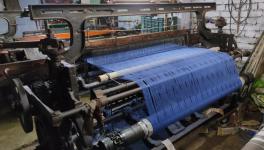India Comes to Champaran, Textile Drum Beats Fading
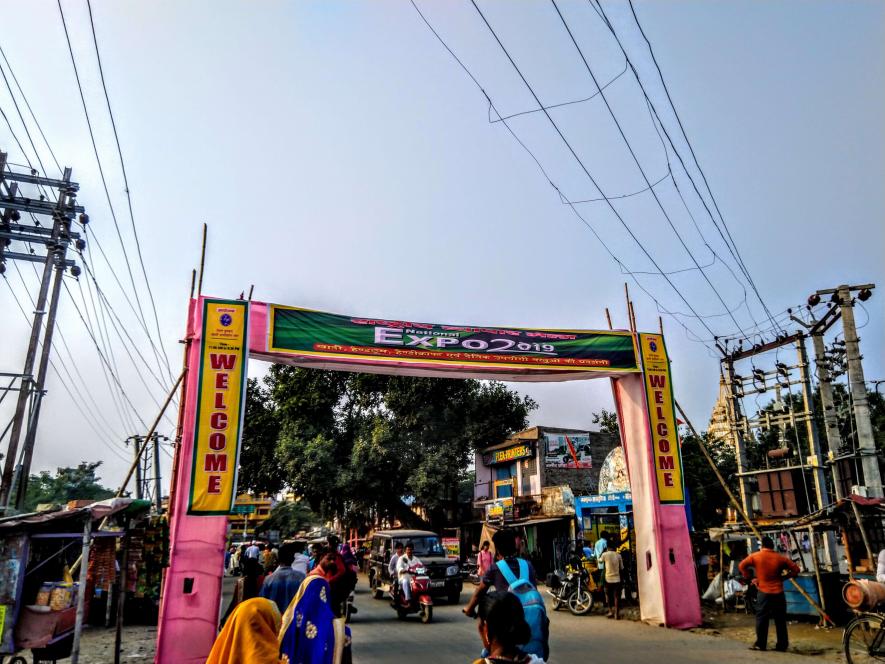
National Expo 2019 entrance.
“There was no consistent source of income,” says Rajdev Paswan, who left his home in district Darbhanga in 1997 in his early teens to search for work in industrial zones. After working in Mumbai, Delhi and elsewhere, in 2016, Paswan landed in Panipat, Haryana’s famous city of weavers. Here he segregates different textile materials at the workshop run by Baldev Katiyal.
Katiyal and Paswan are at the national expo in West Champaran, Bihar, a ten-day fair to foster Indian handlooms and handicrafts that gives manufacturers a platform to display and market their wares.
Alim Ansari, secretary of the NGO, Resham Bunkar Khadi Gramodyog Sangh based in Bhagalpur district, is the brain behind the expo. A weaver himself, Ansari is a traditional expert in the well-known Tussar silk sarees of Bhagalpur. This is the third expo he has set up to preserve the crafts of weaving and handicraft. This year, it is not proving economical for weavers. “Only such mobile fairs can help, or weavers will simply quit the profession,” he says.
The idea behind the expo is to set up stalls in cities to bring the weavers closer to the buyers. This time, the fair has not succeeded. “It’s three days into the fair,” says Feroz Khan, who has a Khadi stall of tee-shirts and kurtas at the expo, which opens at 9 AM and remains open until 8 PM. “But things are not selling.” Feroz, Riyazuddin Saifi and Ankit Jatav are salesmen visiting from the Khadi Cotton Gramodyog in Hapur, Uttar Pradesh. This year, they are struggling to even cover the expenses of the hotel room which costs them Rs 100 per person per day.
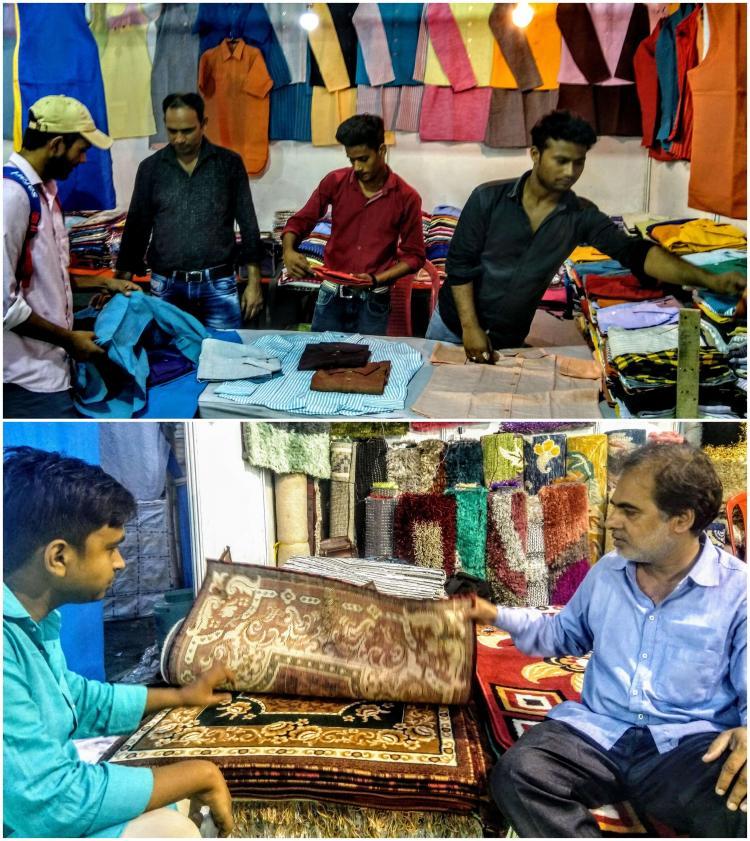
Feroze, Ankit and Riyazuddin [top: left to right] are commission-making salesmen; Fakruddin [bottom] is helping a customer choose a rug.
Saifi, 22, says, “I was earning Rs 12,000 a month. I do not know what Yogiji [Chief Minister of Uttar Pradesh, Yogi Adityanath] did—we were thrown out of work as the fast-food company in our district where we were employed collapsed.” A Hapur resident, he passed his intermediate exams in 2017, in which he studied biology and other science subjects. He laughs in disdain at this. For, forget medicine or research, he has had to work as a manual labourer in order to make ends meet.
Riyazuddin also faced the wrath of industrial closure. In UP, industries have been decimated, employees left jobless, in the last couple of years, he recounts. An organic food company, a processed food company and a plywood industry (where his friends worked) have shut down, he says. Some never cleared their employees dues.
“Lack of collective action is furthering the monopoly of industries and government,” says Riyazuddin. “We have no leader’s support. Will we look forward or stick to the past? If we protest, will it be an investment or amount to wasting our working hours? Everybody knows that the powerless get crushed, but standing against the powerful will also only enfeeble us.”
Feroze’s stall earned a profit of Rs 300 on the day this reporter visited; which the three will share. He hopes for an uptick but the trend of sales so far is not encouraging. To offset poor sales and at least recover their costs, the organisers are charging each visitor Rs10 to visit the stalls this year. “We get no financial assistance from government, except the permit they grant. From power supply to the tents, we manage it all. The tickets help us tackle the conundrum of falling interest,” says Shabir Ahmad, 52. (Setting up the expo cost Rs5 lakh.)
Ahmad’s stall of handloom and powerloom items includes Bhagalpur silk sarees and textiles from Panipat. His two helpers, Vikash Varma, 52 and Lila Ram, 62, say they work on daily wages of between Rs 300 and Rs 400.
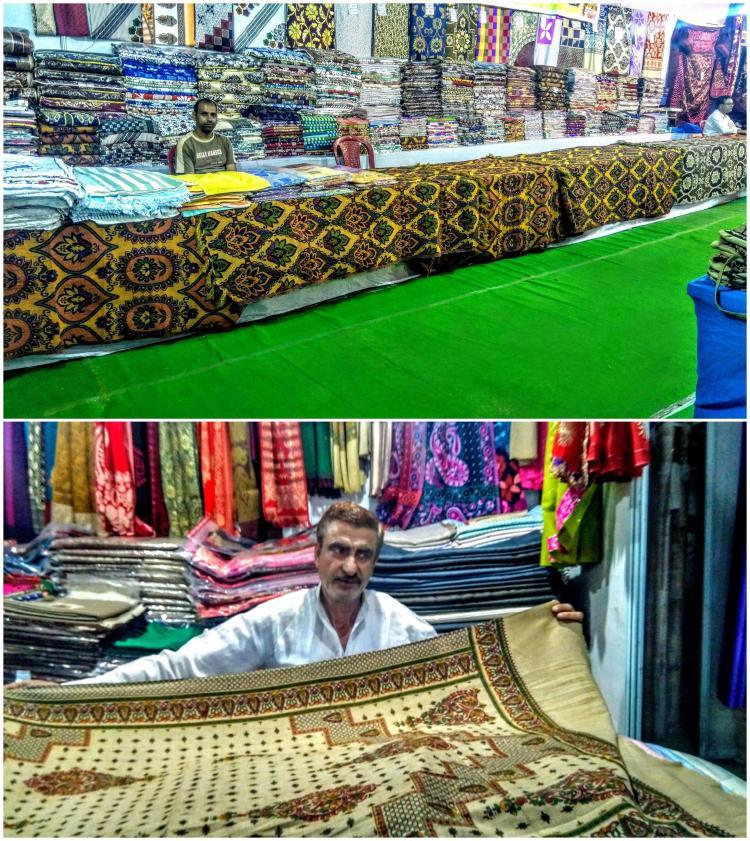
Vikash Varma [left], a helper at Shabirâs shop, is waiting for customers while Baldev tau is trying to persuade customers to buy his products.
Ahmad’s driver, Bulan Kumar Das, 35, also has a stall selling purses, wallets, clutch bags, handbags and pochettes (with magnificent Rajasthani Sanganeri, Bagru and Jaipuri mirror work variations). “Traditional art and craft has no value any more. Even with our shallow profits, buyers are disinterested. It is the same everywhere,” says Das, who has previously set up stalls in Darjeeling, Sitamarhi, Begusarai and Patna. To the falling income of the common man he attributes the decline in sales of “non-essentials” of the kind he sells.
Das’s brother-in-law Rakesh Kumar Das, 19, helps him manage the stall. A resident of Sahpur village of Bahadurpur tehsil of Darbhanga, Rakesh is the youngest of six children and could not finish middle school because his family could not afford it. He now earns Rs300 a day. Rakesh’s family, from the marginalised Dalit community, had to pay a Rs10,000 bribe to access a housing scheme, but they still live in a kuccha house as the first installment of funds has not been discharged.
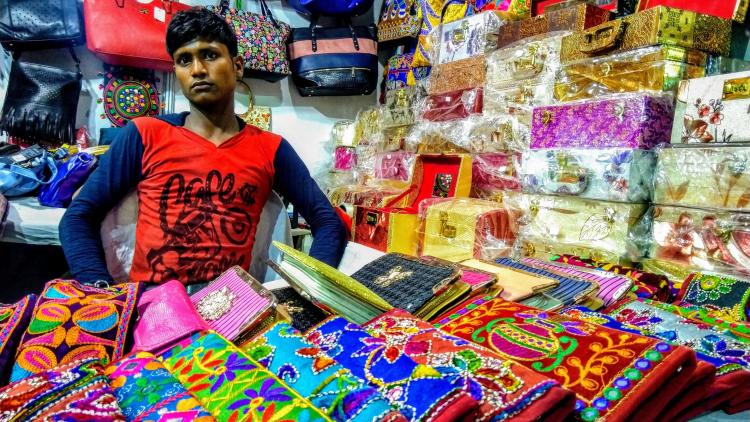
financial problems at home in order to make a career with manual labour.
The conditions are more bizarre for Paswan, whose brother is an officer-bearer in the local panchayat. He did not get the benefit of the Pradhan Mantri Gramin Awaas Yojana despite preference given to his social group, and the poor—and his family meets both requirements.
According to Paswan, the handloom industry in Panipat has undergone a slump. “Earlier Rajdev earned roughly Rs800, now he does not make half as much,” Katiyal admits. “How can he, when there are no employers,” Katiyal says, citing the decline of the locally-dominant manufacturer, Amrit Handloom. “If you [the government] tax textiles heavily, what can employers do [but let go of employees]. Those who were once weavers now sell pakodas and pani-puri or fast food,” he says. “If downsizing goes on, handlooms will soon be history in Panipat.”
Katiyal is stewarding famous the Haryanvi hosiery, Lohi; the three-metre-wide stall is festooned with classic shawls from the state. Weavers like him, unaided by government, are struggling to keep the rich tradition of shawl-weaving alive. Dispirited, he says, “We were somehow fielding off the big and powerful capital-intensive textile players, but the industry is succumbing to Modi’s draconian taxation now.”
In the 1980s, Katiyal had won a land lottery which got him an initial seed capital of Rs 2,000. He then paid equated monthly installments (EMIs) of Rs 132.20 for hundred months. “After eighty months, I got a notice saying that the rates had been raised and now I had to pay Rs 10,000. I did. They asked for more money then,” he says. He withdrew the Rs 40,000 he had invested in the plot—and now it is worth Rs 40,00,000. “Now it is out of my reach,” he says.
Katiyal and his son Gaurav, 26, now ferry handloom products across the country for five months a year, collaborating with traditional curators like Ansari.
The Expo has furniture and wooden artifacts made by famous traditional woodcarvers of Saharanpur district of Uttar Pradesh. Mohammad Sahzad, 33, a carpenter, is trying his best to attract customers but prices do not favour them. “I have spent Rs80,000 to get these items transported across the 1,000 km from Saharanpur to Champaran. If I fail to sell them, it will be a disaster,” he says.
Sahzad’s is the biggest stall at the Expo. Five families depend on his income. His nephews Rahil Mirza and Haider Ali manage another stall selling wooden toys, clocks, rolodexes and other accessories. “If we sell on lower prices, you will call these Chinese. And if prices go high, you will prefer not to buy,” Ali tells a customer. During their last visit to the expo in 2016, there was a rush of customers. “This year is boring,” says Haider. “I do not know what has happened to the people here. Even those who turn up rarely spend.”
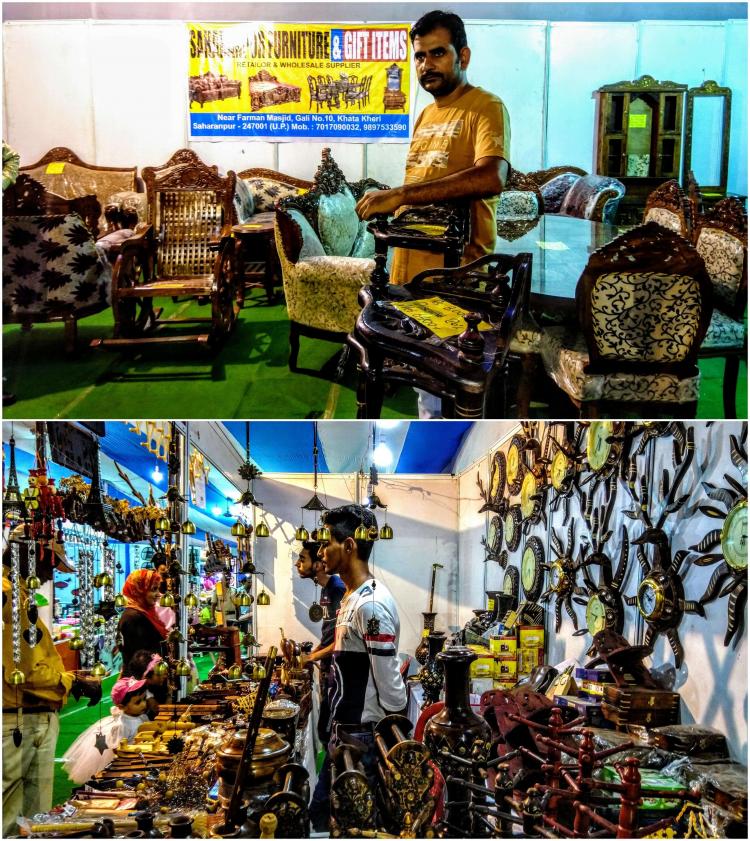
sale, miniature artefacts-extension [bottom] of Sahzad’s
shop is relatively engaging more customers.
The exorbitant prices of wood have affected the wood-crafting business. “Sheesham cost around Rs 150 a maund [~40 kg]. Now, it costs Rs 1,500. Furniture will naturally cost more and this is why customers are drifting away,” he says. On October 25, Sahzad will leave for Sitamarhi district. “The decline in exports has hit Saharanpur’s wood market, and so we are forced to travel around, selling our products,” he says.
Salesmen from mid-to-northern Bihar also have come to sell pickles and candies. Saheb Prasad, 28, from Turkaulia block of East Champaran jumped into this line of work ten years ago. He is a salesman, paid a monthly wage of Rs 8,000 by the owner of the pickle and candy manufacturer. “It is better than seeing our crops washed away by floods at home,” he says. Saheb lost 20 kathhas on which he had grown paddy this year. The paltry income as a salesman is his last resort—and if he sells well, he will celebrate Diwali and Chhath with his family.
Two more salesmen, Ajai Kumar and Dileep Rai, at Alok Chauhan’s pickle stall, earn Rs 7,000 (and regular meals). Dileep, from Subhai locality of Vaishali district, was looking for work when he bumped into Chauhan.

Alok Chauhan [left] and Dileep Rai [right].
Chauhan sells 16 pickle varieties (including the famous Kairi and saag pickles) and also sells washable paintings of Hindu gods and sceneries. He took an informal-sector loan of Rs 2,00,000 at a monthly interest rate of 3% to fund the venture. “No one sleeps hungry—either he earns or begs to be able to eat,” he says. His pickles are attracting customers, but not a single painting has sold.
Bhadohi’s famous handmade carpets, rugs and mats are also here. Fakruddin alias ‘Munna Babu’ met Alim Ansari in Bhagalpur some years ago and was convinced to set up stall at the expo, where he has come this year with his nephew, Seraj Alam. Their carpets sell for Rs 6,000, Rs 2,800 or Rs 800, while doormats go for Rs 250, Rs 150 and Rs 30.
Fakruddin and Seraj have official identity cards issued by the Ministry of Textiles, Government of India. However, they are yet to benefit from this. Fakruddin says that a bribe of Rs 50,000 is demanded to clear a loan of Rs 2,00,000. Artisans from Hapur and Panipat also make similar accusations.
Wooden toys and Seraj Alam.
Fakruddin has put up makeshift stalls for eight years, previously in Patna and Gangtok. “This is not an easy profession,” says Seraj. “First you sweat blood in the blazing summer heat to make carpets. Then you move around the country trying to sell them.”
The problem, according to Seraj, is the “brand consumerism” that has set in. Customers will push us to extremes when haggling over prices but pay ten times more if known company puts their label on the very same product.” Weaving has been modernised only recently; each machine costs Rs 6,000, compared to traditional setup which cost a few hundreds. But the modern setup is efficient.
A class 4 dropout, Seraj regrets quitting school. “You may think of becoming a civil servant but your family’s financial status is the determining variant,” he exclaims. He has an inkling that his younger siblings will end up like him, caring out “an average of Rs 400 a day on the ruins of handwork.”
Get the latest reports & analysis with people's perspective on Protests, movements & deep analytical videos, discussions of the current affairs in your Telegram app. Subscribe to NewsClick's Telegram channel & get Real-Time updates on stories, as they get published on our website.









